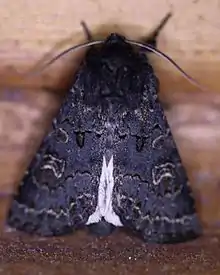Tholera cespitis
Tholera cespitis, the hedge rustic, is a moth of the family Noctuidae. The species was first described by Michael Denis and Ignaz Schiffermüller in 1775. It is found through the Palearctic from Europe to the Altai Mountains of Siberia.
| Tholera cespitis | |
|---|---|
 | |
| Scientific classification | |
| Kingdom: | |
| Phylum: | |
| Class: | |
| Order: | |
| Family: | |
| Genus: | |
| Species: | T. cespitis |
| Binomial name | |
| Tholera cespitis (Denis & Schiffermüller, 1775) | |
| Synonyms | |
| |
Technical description and variation
The wingspan is 34–40 mm. The forewings are dark earth brown; lines indistinct; inner and outer black with paler edges; submarginal pale, with black wedge-shaped spots before it; claviform stigma obscure, black-edged; orbicular roundish, brown with pale ring; reniform large with paler outline, especially externally; hindwing whitish, the veins dark; termen diffusely brownish; in male white, with termen narrowly grey; — ab. ferruginea Hofm. (Carinthia and the Tyrol) is much paler with a reddish-yellow tint.[1]
Biology
There is one generation per year with adults on wing from the end of July to September.
Larva shining dark brown; thoracic and anal plates black; head brown; dorsal and subdorsal lines narrow, pale yellow; lateral stripe broader; spiracles black. The larvae feed on various grasses, including Nardus stricta, Calamagrostis purpurea, Festuca and Deschampsia species.[2] Larvae can be found from March to July. The species overwinters as an egg.
Subspecies
- Tholera cespitis cespitis
- Tholera cespitis armena Hacker, 1986
References
- Seitz, A. Ed., 1914 Die Großschmetterlinge der Erde, Verlag Alfred Kernen, Stuttgart Band 3: Abt. 1, Die Großschmetterlinge des palaearktischen Faunengebietes, Die palaearktischen eulenartigen Nachtfalter, 1914
- Robinson, Gaden S.; Ackery, Phillip R.; Kitching, Ian J.; Beccaloni, George W.; Hernández, Luis M. (2010). "Search the database - introduction and help". HOSTS - A Database of the World's Lepidopteran Hostplants. Natural History Museum, London.
External links
| Wikimedia Commons has media related to Tholera cespitis. |
- Kimber, Ian. "73.252 BF2177 Hedge Rustic Tholera cespitis ([Denis & Schiffermüller], 1775)". UKMoths. Retrieved 10 July 2019.
- Savela, Markku. "Tholera cespitis (Denis & Schiffermüller, 1775)". Lepidoptera and Some Other Life Forms. Retrieved 10 July 2019. Taxonomy
- Lepiforum e.V.
- De Vlinderstichting (in Dutch)